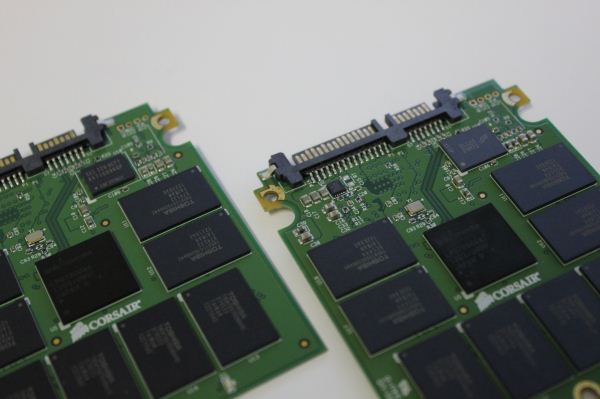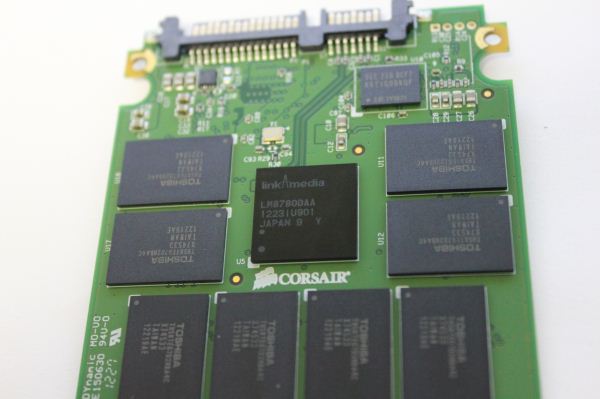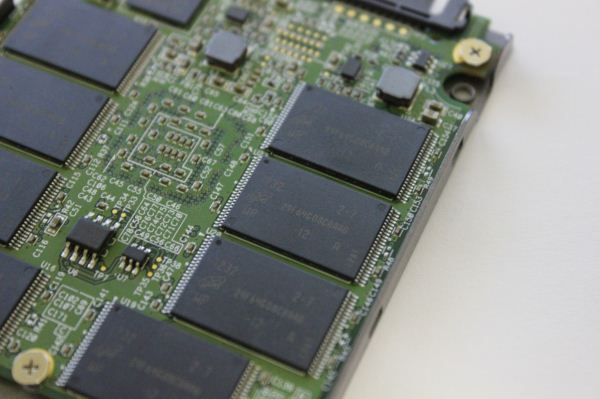Corsair Neutron & Neutron GTX: All Capacities Tested
by Kristian Vättö on December 19, 2012 1:10 PM ESTThe Drives
Corsair surprised us all at Computex this year when they announced their Neutron and Neutron GTX SSDs based on a so-far relatively unknown Link A Media Devices (LAMD) controller. While LAMD was new to the consumer-grade SSD controller market, the company had been making controllers for hard drives and enterprise SSDs for years, so the LM87800 found inside Neutron SSDs wasn't LAMD's first attempt in the storage world. The experience LAMD has gathered in the enterprise world is definitely visible in the LM8700 because even though its LAMD's first consumer-grade controller, it was not dwarfed by SandForce or Marvell.
Overall we were pleasantly surprised with the Neutron when we first reviewed it. There's always room for more competition because not only will it lead to lower prices, it will also provide the market with better products. Lately the consumer SSD market has been flooded with SandForce based SSDs, so it was very refreshing to see something new for a change.
Corsair only sampled the 240GB Neutron and Neutron GTX at the time of the release, which is a common practice among manufacturers. Stock is obviously limited and manufacturers want to get as many units as possible to retailers because ultimately that is what generates them revenue and profit. 240/256GB is usually the sweet-spot in terms of price and performance; smaller capacities perform worse due to less NAND die and higher capacities don't bring any improvements because the bottlenecks are elsewhere (*cough* SATA 6Gbps).
Now, three months later, Corsair finally sent us the rest of the available capacities. Testing different capacities is crucial, especially if the drive has a new controller, because controllers and firmware are designed differently and some design choices result in bigger differences between smaller and larger capacities. For example, the 128GB Vertex 4 is almost as fast as its 256GB and 512GB siblings, whereas the difference between 120GB and 240GB Vertex 3 ranges from negligible to as much as 50-75% (e.g. in write-heavy scenarios). Here's the quick rundown of the various drives.
| Neutron | Neutron GTX | ||||
| Capacity | 120GB | 240GB | 120GB | 240GB | 480GB |
| Raw NAND Capacity | 128GiB | 256GiB | 128GiB | 256GiB | 512GiB |
| NAND | Micron 25nm synchronous MLC | Toshiba 24nm Toggle-Mode 2.0 NAND | |||
| Cache | 128MB | 128MB | 128MB | 128MB | 256MB |
| Sequential Read | 555MB/s | 555MB/s | 555MB/s | 555MB/s | 555MB/s |
| Sequential Write | 211MB/s | 370MB/s | 330MB/s | 511MB/s | 511MB/s |
| 4KB Random Read | 50K IOPS | 85K IOPS | 80K IOPS | 85K IOPS | 90K IOPS |
| 4KB Random Write | 86K IOPS | 87K IOPS | 90K IOPS | 90K IOPS | 85K IOPS |
| Warranty | 5 years | ||||
Toshiba's Toggle-Mode NAND is quite a bit faster than Micron's synchronous ONFi NAND as you can see in the table above. The 120GB Neutron is substantially slower than the 120GB Neutron GTX and there is also a noticeable difference at the capacity of 240GB. Corsair isn't offering a 480GB Neutron so if you're looking for a drive bigger than 240GB, you'll have to pay the premium for the Neutron GTX. Quite a few manufacturers, such as Intel and Plextor, have similar product schemes where only the high-end model offers the highest capacities (Intel SSD 330 tops out at 240GB and Plextor M5S at 256GB).
| Comparison of NAND Interfaces | ||||||
| ONFi | Toggle-Mode | |||||
| Manufacturers | IMFT (Intel, Micron, Spectec), Hynix | Toshiba/SanDisk, Samsung | ||||
| Version | 1.0 | 2.0 | 2.x | 3.0 | 1.0 | 2.0 |
| Max Bandwidth | 50MB/s | 133MB/s | 200MB/s | 400MB/s | 166MB/s | 400MB/s |
The Toggle-Mode interface can currently provide up to twice the bandwidth of ONFi. The interface alone isn't the reason for the difference in performance; Toshiba's NAND is also considerably faster when it comes to program times based on the data I've seen, which would explain why only write speeds are slower on the Neutron.
| Price Comparison (12/18/2012) | |||||
| 120/128GB | 240/256GB | 480/512GB | |||
| Corsair Neutron GTX | $130 | $225 | $455 | ||
| Corsair Neutron | $120 | $190 | N/A | ||
| Corsair Force GS | N/A | $200 | $410 | ||
| Corsair Force GT | $130 | $220 | $440 | ||
| Plextor M5 Pro | $125 | $200 | $460 | ||
| Plextor M5S | $105 | $200 | N/A | ||
| Crucial m4 | $110 | $190 | $383 | ||
| Intel SSD 520 | $129 | $220 | $445 | ||
| Intel SSD 330 | $113 | $179 | N/A | ||
| Samsung SSD 840 Pro | $139 | $260 | $577 | ||
| Samsung SSD 840 | $100 | $169 | $315 | ||
| OCZ Vector | $150 | $270 | $555 | ||
| OCZ Vertex 4 | $108 | $210 | $458 | ||
Neither the Neutron or the Neutron GTX is the cheapest SSD available, but the pricing is still fair. Compared to the OCZ Vector or Samsung SSD 840 Pro, the Neutron GTX is actually quite a bit cheaper, although performance is at a different level as well. As always, prices fluctuate a lot so it's hard to draw any conclusions based on one day's pricing—it can be totally different in less than a week.
In fact, just to show you how prices fluctuate, here's the same table as above, only with prices from just over two weeks ago; I've italicized and bolded the differences, which you can see is about 80% of the SSDs we've listed. Sure, it's the Christmas season and so we're more prone than ever to price fluctuations, but in particular some of the newer drives (like the Samsung 840 500GB) as well as some of the older outgoing models (e.g. OCZ Vertex 4 and Intel 520) have seen some pretty heft price cuts. Be sure to shop around!
| Price Comparison (12/1/2012) | |||||
| 120/128GB | 240/256GB | 480/512GB | |||
| Corsair Neutron GTX | $140 | $230 | $470 | ||
| Corsair Neutron | $120 | $205 | N/A | ||
| Corsair Force GS | N/A | $220 | $450 | ||
| Corsair Force GT | $130 | $220 | $440 | ||
| Plextor M5 Pro | $130 | $250 | $460 | ||
| Plextor M5S | $110 | $200 | N/A | ||
| Crucial m4 | $110 | $200 | $385 | ||
| Intel SSD 520 | $130 | $250 | $490 | ||
| Intel SSD 330 | $115 | $200 | N/A | ||
| Samsung SSD 840 Pro | $194 | $270 | $600 | ||
| Samsung SSD 840 | $105 | $179 | $392 | ||
| OCZ Vector | $160 | $290 | $570 | ||
| OCZ Vertex 4 | $140 | $236 | $475 | ||
Inside the Drives
| NAND Type | NAND Configuration | NAND Part Number | |
| Neutron | |||
| 120GB | Micron 25nm synchronous MLC | 16x 8GiB packages | 29F64G08CBAAB |
| 240GB | 16x 2x8GiB packages | 29F128G08CFAAB | |
| Neutron GTX | |||
| 120GB | Toshiba 24nm Toggle-Mode MLC | 8x 2x8GiB packages | TH58TEG7D2HBA4C |
| 240GB | 8x 4x8GiB packages | TH58TEG8D2HBA4C | |
| 480GB | 8x 8x8GiB packages | TH58TEG9D2HBA4C |
Neutron GTX 120GB and 480GB
In general, the only difference between the various capacities is the amount of cache and NAND per die. The 480GB model is the only one with 256MB (two 128MB chips) of cache; other models have 128MB. Both DRAM caches are DDR2-800 like in the 240GB Neutron GTX, but Corsair has opted for Micron's DRAM in the 480GB model whereas the 120GB and 240GB models use DRAM from Samsung.
LM87800—The heart of Corsair's Neutron series
Micron's ONFI NAND in 120GB Neutron
Test System
| CPU |
Intel Core i5-2500K running at 3.3GHz (Turbo and EIST enabled) |
| Motherboard |
AsRock Z68 Pro3 |
| Chipset |
Intel Z68 |
| Chipset Drivers |
Intel 9.1.1.1015 + Intel RST 10.2 |
| Memory | G.Skill RipjawsX DDR3-1600 2 x 4GB (9-9-9-24) |
| Video Card |
XFX AMD Radeon HD 6850 XXX (800MHz core clock; 4.2GHz GDDR5 effective) |
| Video Drivers | AMD Catalyst 10.1 |
| Desktop Resolution | 1920 x 1080 |
| OS | Windows 7 x64 |













44 Comments
View All Comments
nedjinski - Wednesday, December 19, 2012 - link
I wish you could somehow get Mushkin SSD's into the mix :)Kristian Vättö - Thursday, December 20, 2012 - link
I've asked Mushkin for review samples several times but for some unknown reason, they have never sent us any. And yes, I've tried emailing them again and again but I haven't gotten any replies...Mumrik - Thursday, December 20, 2012 - link
That's weirdly worrying.AT isn't exactly a small hardware-grabbing site.
ICBM - Wednesday, December 19, 2012 - link
It was mentioned that the LAMD controller isn't in the same class as Vector/840Pro, however it seems like it only loses a couple of benchmarks. The others it is winning or just slightly behind. So is it really not up to par with OCZ and Samsung? Would the average user, heck scratch that. Would the most avid enthusiast know the difference between an 840 Pro and a Neutron GTX running in their system?Beenthere - Wednesday, December 19, 2012 - link
In actual use no one is likely to be able to tell the difference in performance between a SATA 2 drive compared to a SATA 3, let alone between the recent crop of SATA 3 SSDs.People should do their homework before jumping in to an SSD. If you chose to go forward at least you'll know which drives to definitely avoid and which ones are the cheapest. Don't assume because an SSD is a familair brand name that it is either reliable nor fully compatible because you may be in for quite a rude awakening. It's foolish to pay more based on some perceived benefit in benchmarks when it means nothing in actual use.
Denithor - Thursday, December 20, 2012 - link
This is very true.I switched from a 120GB Intel 320 (SATA 2) to a 180GB Intel 330 (SATA 3) and the only difference I could see/feel was the increased capacity of the new drive. Boot times were nearly identical, apps open at the same speeds, no discernible improvement from the upgrade.
hammer256 - Wednesday, December 19, 2012 - link
Those consistency results are pretty remarkable. From newegg reviews, however, it appears to have a bimodal distribution of 5's and 1's, but the sample size is pretty small. Still, I wonder how good their QC is...skytrench - Thursday, December 20, 2012 - link
Not really, the consistency tests on a 100% full and 100% fragmented drive with nonstop 4k random writes, doesn't reflect reality. You wouldn't even allow your ZFS filesystem to reach that state! Some better test should be devised.nushydude - Thursday, December 20, 2012 - link
which SSD to get strictly for OS, applications and games? i think Neutron GTX is too much because i won't be writing much data. a Samsung 840 should suffice? i want better performance than a 120GB Kingston HyperX (original one) btw.nathanddrews - Thursday, December 20, 2012 - link
Simple, use the light workload storage benchmarks and select any drive that performs better than your current SSD.I'll even be really nice and provide you with a link. :-)
http://www.anandtech.com/bench/SSD/269